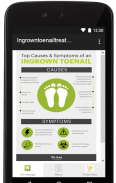





Ingrown Toenail Treatment

Description of Ingrown Toenail Treatment
What is an ingrown toenail, and what causes it? It’s a common condition in which the corner or side of a toenail grows into the soft flesh. Many anatomic and behavioral factors are thought to contribute to ingrown toenails, such as improper trimming, repetitive or inadvertent trauma, genetic predisposition, hyperhidrosis, and poor foot hygiene.
Ingrown toenails are classified into three categories: mild (stage 1), moderate (stage 2) and severe (stage 3). Mild cases are characterized by nail-fold swelling, erythema, edema and pain with pressure. Moderate cases are associated with increased swelling, drainage, infection and ulceration of the nail fold. The most severe cases of ingrown toenail exhibit chronic inflammation and granulation, as well as marked nail-fold hypertrophy.
Regardless, the result is pain, redness, swelling and, sometimes, an infection. Ingrown toenails usually affect the big toe, though other toes can also be affected. Most often, ingrown toenails can be self-treated. However, if the pain is severe or spreading, you may need to check in with your doctor to relieve your discomfort and help you avoid further complications.
How can you be sure you have an ingrown toenail? If you have any of the following symptoms, chances are you do:
Pain and tenderness in your toe along one or both sides of the nail
Redness around your toenail
Swelling of your toe around the nail
Infection of the tissue around your toenail
The good news is this app can tell you how to get rid your ingrown toenail problem and by doing its treatment at home.
10 steps detailed with pictures cant go wrong and you will like this apps.
Download,open, and follow this apps advices then your ingrown toenail problem will be not living in your hair forever!





















